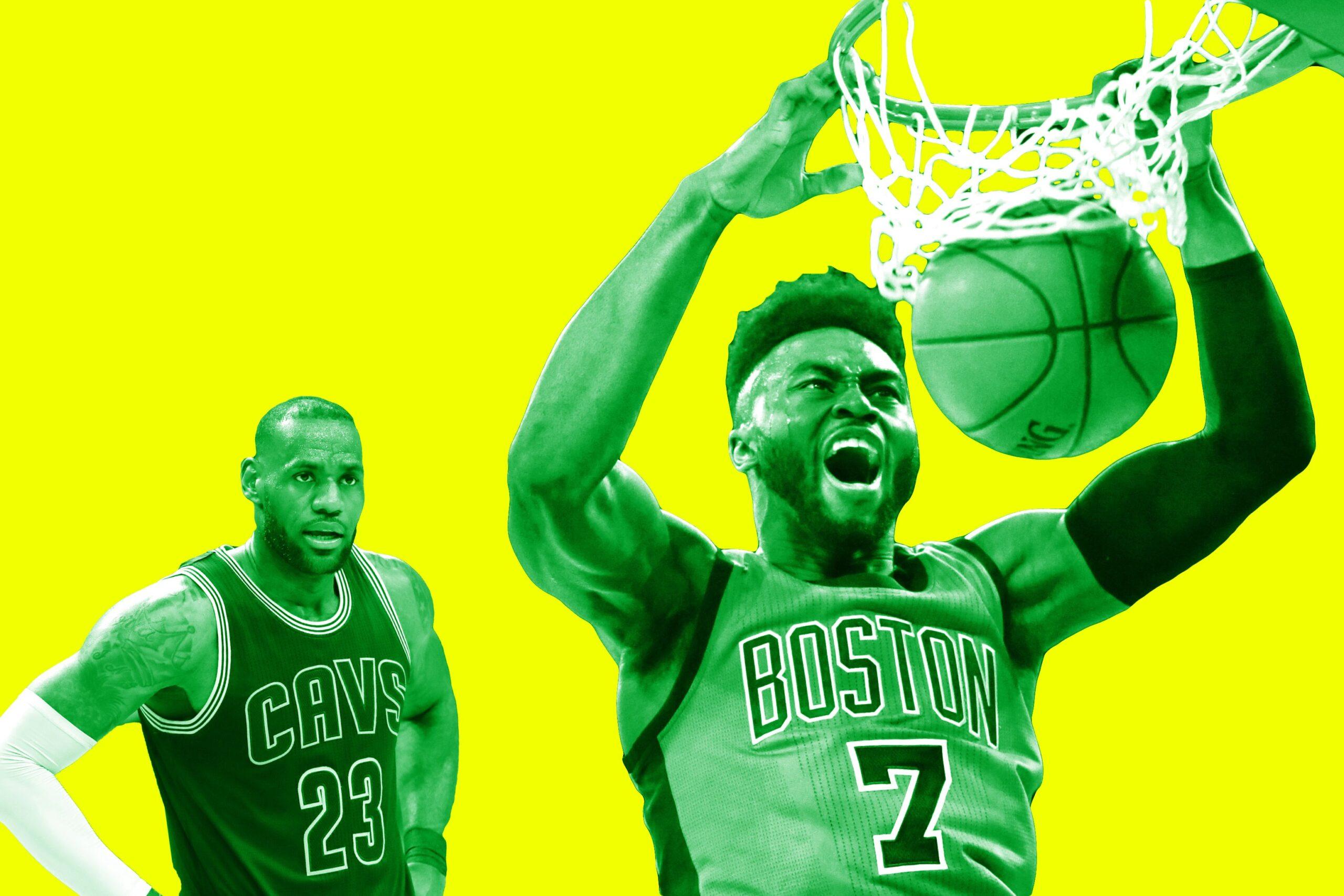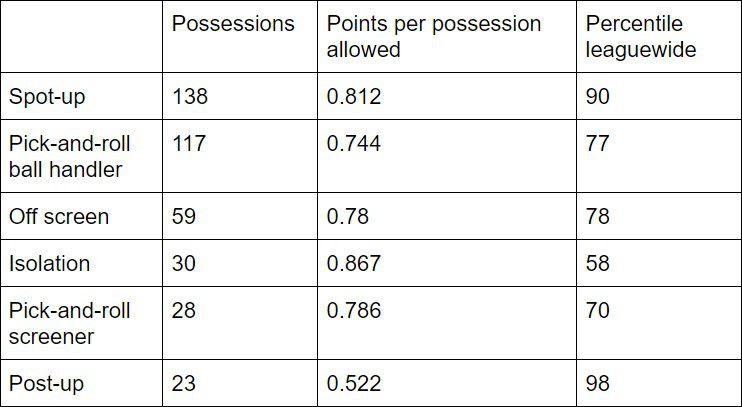
Jaylen Brown picked the perfect time for a breakout game. The no. 3 pick in last year’s draft, Brown had been a valuable member of the Celtics rotation in the regular season, but he hadn’t made much of an impact in the playoffs before Game 7 of their second-round series against the Wizards. Brown was plus-8 in 20 minutes on Monday, with nine points on 3-of-5 shooting, three rebounds, and one steal, and he made several huge plays at the end of the third quarter that helped blow the game open. For one game, Brown showed how important his unique combination of size and athleticism can be to the Celtics. Now, against the Cavs in the Eastern Conference finals, they are going to need him to be even better.
Boston is the latest in a long line of challengers to LeBron James, who has steamrolled his way to six consecutive NBA Finals. LeBron hasn’t lost a playoff series against a team from the East since 2010, when the Big Three Celtics ended his first stint in Cleveland. He has been doing this for so long that he’s now facing an entirely new generation of Celtics. Still only 32, LeBron is at the height of his powers, averaging 34.4 points on 55.7 percent shooting, 9.0 rebounds, and 7.1 assists a game in the playoffs and leading the Cavs to consecutive sweeps of the Pacers and Raptors. The only thing standing in his way is a raw 20-year-old rookie, and how Brown fares in the next two weeks will go a long way toward determining not only his team’s future, but his own.
The Celtics were 1–3 in four games against the Cavs in the regular season, with their only win coming in a game that Kevin Love missed. LeBron demolished them in the first round of the playoffs two years ago, and he has been just as big a problem for them this season. Boston has a lot of talented perimeter defenders, but none of them match up well with the league’s best player. Avery Bradley (6-foot-2 and 180 pounds) and Marcus Smart (6-foot-4 and 220 pounds) might as well be gnats to a guy listed at 6-foot-8 and 250 pounds, while Jae Crowder and Al Horford don’t have the speed to corral his penetration and prevent him from living at the rim. Check out this supercut of laughably easy baskets that LeBron scored in a 114–91 victory over the Celtics on April 5:
At 6-foot-7 and 225 pounds with a 7-foot wingspan, Brown at least has the size and speed to conceivably stay in front of LeBron and contest his shot. He’s a kid who looks like he’s been living in the weight room for the past decade, with a chiseled frame unusual for a player his age. Combine that strength with the ability to explode off the ground and hang in the air, and it’s no surprise Brown was considered one of the best players in his high school class. He can take your breath away at times, and he’s already put together an impressive highlight reel of athletic plays in his short time in Boston. In this sequence, he fronts Marcin Gortat in the post, forces a turnover, and then runs the break and makes a beautiful, acrobatic finish at the rim:
While many young players come into the league with little idea of how to harness their physical tools, Brown has carved out a spot for himself in the Boston rotation because of his ability to get down in a stance, slide his feet on the perimeter, and bang with bigger players in the lane. With so many veterans ahead of him, there aren’t many shots for Brown in the half-court offense, so he has to affect the game in other ways. The defining play for Brown on Monday came when he was lying prone on the floor, yet still managed to prop himself up, lunge for the ball while parallel to the court, and secure the rebound away from the outstretched arms of Otto Porter Jr.:
The rise of the spread pick-and-roll, which allows the offense to pick and choose exactly where they want to attack on defense, has put a premium on defensive versatility around the league, and few guys are more comfortable switching screens and defending multiple positions than Brown. He guarded everyone from John Wall to Gortat at various points in the Wizards series. Not many players, much less rookies, are as capable at defending as many different types of actions as Brown (numbers courtesy of Synergy Sports):

On the offensive side of the ball, Brown is mainly asked to stand in the corner and stay out of the way. He had a usage rate of only 17.8 this season, and according to the tracking numbers at Synergy, 69 percent of his offensive possessions came on spot-ups, cuts, offensive rebounds, and transition plays. The biggest key for Brown is knocking down open 3s, and he shot a respectable percentage as a rookie, making 34.1 percent on 1.7 attempts per game. When he’s hitting outside shots, it creates more room for Isaiah Thomas and Al Horford to operate, and it opens up driving lanes to the rim, where he’s at his best. He can contort his body and finish in traffic, so getting to the free throw line should be a huge part of his game as he gets older:
Brown’s emergence in Game 7 was crucial because power forward has been the biggest hole in the Celtics rotation. Brad Stevens has shifted between Amir Johnson and Gerald Green in the starting lineup over the last few weeks, and neither has provided much consistency. Green is a streaky shooter prone to flights of fancy on defense, while Johnson has looked like a shell of himself, unable to finish at the rim, compete on the boards, or guard anyone. They have the two lowest playoff net ratings of any player in the Boston rotation. Playing Brown allows Stevens to slide Crowder to power forward, and in the 58 minutes the two have played together in the postseason, Boston has a net rating of plus-9.5.
Brown will probably not start on Wednesday, but Stevens may not waste much time bringing him off the bench. After his starters got out to a slow start in the first three minutes of the second half of Game 7, he inserted Brown into the game. It was a tremendous amount of trust to put in such a young player, and made for a stark contrast with the approach of Scott Brooks, who benched second-year wing Kelly Oubre Jr. in Game 7 and played his veterans to disastrous results. Having to rely so heavily on Brown is far from ideal, but that was inevitable when the Celtics didn’t pull the trigger on a blockbuster trade at the deadline. In an alternate timeline, Jimmy Butler or Paul George would have gotten the assignment on LeBron, and the matchup between the two teams would be a lot closer. Instead, with Boston threading the needle between competing now and building for the future, they decided not to go all in this season.
A no. 3 overall pick would be a cornerstone for most NBA teams, but the Celtics have so many young players and future draft picks coming down the pipeline that Brown’s long-term role with the franchise is unsettled. They will likely add 2016 first-round picks Guerschon Yabusele and Ante Zizic to the roster next season, and they have the no. 1 overall pick in the 2017 draft thanks to a laughably lopsided trade with the Nets, as well as Brooklyn’s pick in the 2018 draft, which promises to yield yet another high lottery selection. That doesn’t even take into account the Celtics’ potentially signing Gordon Hayward to a max contract in the offseason, or pulling off one of the long-rumored trades for Butler or George.
Brown could develop into an All-Star-caliber player as a primary option, although he struggled in that role in his one season at Cal. Brown averaged 14.6 points and two assists a game as a freshman, but his middling shooting percentages (43.1 percent from the field, 29.4 percent from 3) and high turnover rate (3.1 a game) were red flags in terms of how his game would translate to the NBA. He never seemed comfortable making decisions and reading the floor, and he settled for way too many difficult shots off the dribble. Like many über-athletic young players, Brown never had to become a complete offensive player because he could dominate based solely on his absurd physical ability at lower levels of the game. While part of the issue was a poor fit on a Cal team that preferred to play in the half court despite having virtually no floor spacing, Brown’s uneven performance still raised questions about just how good he could become as a pro.
Brown is in a much better situation in the NBA, getting his feet wet on an experienced team that doesn’t need much from him offensively. The Celtics haven’t pushed Brown outside his comfort zone much this season, but that’s going to change against the Cavs. They need him to accelerate his developmental timetable: A 25-year-old version of Brown would be much better equipped to handle LeBron than a 20-year-old version. However, if he doesn’t play well over the next few weeks, he may not even be in their plans in a few years. Brown has had a good rookie season, but there could be even better versions of him available to the Celtics in the next two drafts, as well as in trades and free agency. If he can put his stamp on the conference finals, he could go from a complementary piece to a building block. The future is now for Jaylen Brown.

